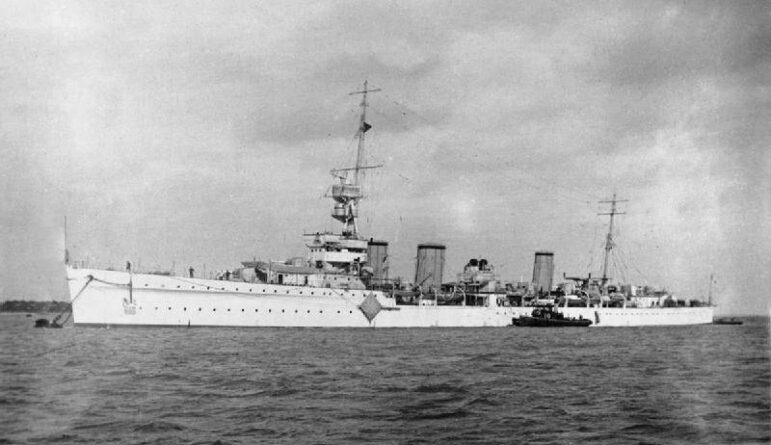
Labeled “TOP SECRET” it was one of the most secretive missions of the Second World War, and one of the most interesting. Even today, most senior banking officials in Canada had no idea this mission ever occurred. This is an amazing part of World War II history.
During the summer of 1939, the HMS Emerald, part of the Royal Navy embarked on a highly secretive mission as it sailed across the North Atlantic Ocean bound for Halifax, Nova Scotia, Canada. The cargo being transported was Prime Minister Winston Churchill’s first convoy of “fish boxes.” This was no small flotilla. The HMS Emerald was part of the Emerald Class light cruisers (called light armored cruisers) which measured 570 feet in length and carried a crew of more than 550. These light cruisers served in a variety of roles, primarily as convoy escorts and destroyer command ships, but also as scouts and fleet support vessels for battle fleets. Accompanied by additional ships, light cruisers, destroyer escorts and two aging battleships, the HMS Emerald made the very treacherous 2850 Mile, 7-day journey across the North Atlantic beating back fierce sea and waves reaching 25 feet … unscathed! What made this crossing so remarkable was that convoys (totaling 40 – 50 ships) who made these transatlantic crossings were like ducks in a shooting gallery for German U-Boats, known as the marauding German Wolfpacks. The Battle of the Atlantic was well underway and convoy crossings were very dangerous and incurred horrendous casualties. Some crossings saw sinkings that exceeded 40% of the entire convoy, and with 50 ships and crew that amounted to 20 sinkings. Into the summer of 1940 more of Churchills “fish convoy” crossings were made that included the HMS Revenge, HMS Resolution and HMS Enterprise.
Upon HMS Emerald’s arrival in Nova Scotia, officials from both the Bank of Canada and the Canadian National Express (known today as the CNR, the Canadian National Railway) were waiting. The arriving boxes of fish were inspected and reinspected before they were loaded onto rail cars, at which point over 250 armed guards were assigned to guard the shipments of fish boxes as they made the 300-mile journey to Montreal. 250 armed guards for fish, you might ask, and you would be right. This is where the story gets interesting, but let us back up for a minute.
By June 1940, as Prime Minister Winston Churchill was forming his government, the war was not going well for the Allies. Italy had joined the war but on Germany’s side. The Germans had crossed Europe, had marched through Paris and had also surrounded the Allies in southern France at Dunkirk. The Germans were poised to cross the English Channel and invade the United Kingdom. With the fear that the UK could fall, Winston Churchill devised a grand scheme to install his government in Montreal, Canada and lead the Commonwealth’s war effort from there. This plan also included having the Bank of England establish a secondary operation to be headquartered in Canada’s capital, Ottawa. Since 1938, the UK government had been buying more gold, but with the Germans at their front door, Churchill decided to ship its entire reserves of gold bullion overseas to Canada. The operation would be called; “Operation Fish.”
The end game was to pack the gold bullion, securities and coins from the Royal Treasury into crates with fish, covered by ice. Amazing as this may sound, upon completion of Operation Fish … of the nearly 140 ships that were sunk during these convoy crossings, not one of the ships carrying the UK’s wealth was ever sunk. By the end of the Operation Fish, over 1500 tons of gold bullion had made its way across the North Atlantic Ocean to Canada.
In Canada, the coins and securities were stored in a specially designed vault that was located three levels below the Sun Life Building in Montreal. It was guarded by the Royal Canadian Mounted Police (RCMP) 24/7. The securities were eventually sold over the coming years on the New York Stock Exchange to fund Britain’s ongoing war efforts. The gold bullion was shipped from Montreal to Ottawa, where it was stored in vaults of the Bank of Canada.
The value of these gold shipments in 1940 was estimated to be £470 million, which at today’s market value would be over $300 Billion. It is deemed to be the largest transfer of wealth, from country to country in world history.
Throughout the entire operation, and despite many thousands of people having been involved in the unparalleled efforts for this highly secretive mission, Operation Fish remained a secret until after the war. To its credit, no securities, coins or a single gold bar ever went missing. So, this is a fish story that I think will top any one you are likely to hear.